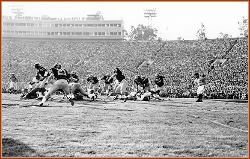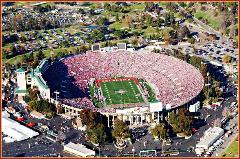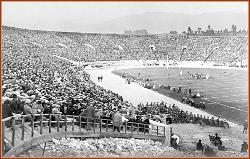Yankee Stadium
Only a year after
they changed
Baseball forever with
the purchase of
Babe Ruth from the
Boston Red Sox, the
Yankees made
another buy that
would forever
change the way the
game was watched.
On February 6,
1921, the Yankees
issued a press
release to announce
the purchase of 10
acres of property in the west Bronx. The land, purchased from the estate of
William Waldorf Astor for $675,000, sat directly across the Harlem River from
the Yankees' current Manhattan home, the Polo Grounds, which they shared
unhappily with the landlord Giants of the National League since 1913.
The relationship between the Giants and their tenant crumbled after the 1920
season when Yankee attendance boosted by their new slugging sensation
doubled to 1,289,422. That was over 100,000 more than the Giants, who, in
1921, notified the Yankees to vacate the Polo Grounds as soon as possible.
With their departure from the Polo Grounds now inevitable, Yankee co-owners
Jacob Ruppert and Tillinghast l'Hommedieu Huston set out to build a
spectacular ballpark of their own, Baseball's first triple-decked structure. With
an advertised capacity of 70,000, it would also be the first to be labeled a
"stadium."
Original plans of the architect the Osborne Engineering Company of Cleveland,
Ohio had the Stadium triple-decked and roofed all the way around. An early
press release, in fact, described the Yankees' new home as a field enclosed
with towering embattlements, rendering the events inside "impenetrable to all
human eyes, save those of aviators." But the initial, grand design was quickly
scaled back with the triple-decked grandstand not reaching either foul pole.
Contrary to the owners' wishes, the action would be more than visible from the
elevated trains that passed by the outfield as well as from the buildings that
would spring up across River Avenue. Fortunately, a purely decorative element
also survived the project's early downsizing and would become the park's most
recognizable feature. A 15-foot deep copper facade would adorn the front of
the roof which covered much of the Stadium's third deck. It would give Yankee
Stadium an air of dignity that no park has possessed -- either before or since.
The new stadium would favor lefthanded power with the right-field foul pole only
295 feet from home plate (though it would shoot out to 429 by right center).
Though the left-field pole measured only 281 feet from the plate, righthanded
hitters were neutralized by a 395-foot left field and a whopping 460 to left
center. It would also be friendly to patrons, boasting an unheard of "eight toilet
rooms for men and as many for women scattered throughout the stands and
bleachers." (When the Stadium was remodeled 50 years later, it included more
than 50 restrooms.) The club's executive offices would be moved from midtown
Manhattan and located between the main and mezzanine decks with an electric
elevator connecting them with the main entrance.
The construction contract was awarded to New York's White Construction Co.
on May 5, 1922 with the edict that the job must be completed "at a definite
price" ($2.5-million) and by Opening Day 1923. Incredibly, it was. In only 284
working days, Yankee Stadium was ready for its inaugural game on April 18,
1923 vs. the Boston Red Sox.
Officially, 74,200 fans packed Yankee Stadium for their first glimpse of
Baseball's grandest facility while thousands more milled around outside after
the fire department finally ordered the gates closed. Before the game began,
John Phillip Sousa and the Seventh Regiment Band led both clubs to the
flagpole in deep center field where the American flag and the Yankees' 1922
pennant were raised. Appropriately, Babe Ruth christened his new home with a
three-run homer to cap a four-run third inning as the Yankees coasted to a 4-1
win.
Because it was widely recognized that Ruth's tremendous drawing power made
the new stadium possible, it would immediately become known as "The House
That Ruth Built." Later that season, the Stadium hosted the first of 33 World
Series and the Yankees won their first World Championship over their former
landlord, the Giants. Of course, as the Stadium became the stage for a
staggering number of World titles - now totaling 26 - it also would become
known as "The Home of Champions."
In its early years, when wooden bleachers surrounded the outfield, a grass
slope approached the outfield walls from foul pole to foul pole. Outfielders,
especially Ruth in right, routinely backed up the small hill to pull down fly balls.
Atop the bleachers were advertising signs except for a lone, manually operated,
wooden scoreboard in right-center field which was "big enough to record 12
innings for games played by every club in the two major leagues." Over the
years, the board would be replaced by more modern models. The Yankees, in
fact, would unveil the first electronic message board in 1959. By 1928, the
Stadium was ready for its first major facelift as the triple-deck grandstand in left
field was extended beyond the foul pole to its current termination point. The
right-field grandstand was extended in 1937, allowing "upper-deck" home runs
in both directions. With the '37 expansion of the grandstand, the remaining
wooden bleachers were replaced by a concrete structure and the distance to
center field dropped from 490 feet to a still-astronomical 461 feet.
Except for the addition of lights in 1946, the look of Yankee Stadium would now
remain relatively the same until the winter of 1966-67. Then, under the direction
of its new owner, CBS, the 44-year-old facility received a $1.5-million
modernization, most of which was spent on paint (90 tons of it). The brown
concrete exterior was painted white as was the by-now greenish copper facade.
And all of the grandstand seats went from green to blue, a color scheme that
would be retained when the Stadium was completely remodeled after the 1973
season.
On August 8, 1972, after years of debate about the future of the aging ballpark,
the Yankees signed a 30-year lease with the City of New York which called for
Yankee Stadium to be completely modernized in time for the 1976 season. After
completing the Stadium's 50th-Anniversary season in 1973, the Yankees moved
to Shea Stadium for two seasons while their home was almost completely
demolished and then rebuilt.
The most striking change of the modernization would be the removal of the
numerous, obstructive steel columns which supported the second and third
decks as well as the roof. By "cantilevering" the upper decks and by lowering
the playing field while increasing the slope of the lower stands, sight lines for
fans would be dramatically improved. Of course, with the removal of the original
roof, the Stadium almost lost its most-recognizable feature: the facade. But an
innovative design concept included an exact replica of the facade atop the new
560-foot-long scoreboard which stretched across the rear of the bleachers. The
board would also include baseball's first "telescreen," which could provide
instant replays of the action by emplying a then-incredible "nine shades of gray."
Yankee Stadium's exterior changed dramatically, too, as three escalator towers
were added, one at each of the Stadium's three entrances. And, with 10
additional rows of seats added to the upper deck, the already-grand Stadium
would have an even more majestic look.
The remodeled Yankee Stadium opened on April 15, 1976 with the Yankees
topping Minnesota 11-4 and, like its predecessor, would host the World Series
in its inaugural season. The Stadium, in fact, hosted the Fall Classic in its first
three seasons with the Yankees winning back-to-back World titles in 1977 and
1978.














